Novel casting CoCrNiAl eutectic high entropy alloys with high strength and good ductility
Abstract
Eutectic high-entropy alloys (EHEAs) have drawn increasing interest due to their fine castability as well as appealing properties in recent years. In this work, two bulk-casting Co20-x/3Cr20-x/3Ni50-x/3Al10+x (x = 8 and 9) EHEAs with regular L12/B2 lamellar morphologies were successfully fabricated and studied. Both EHEAs show high ultimate strength of ~1200 MPa combined with good uniform ductility (> 9%). Post-deformation transmission electron microscopy results indicated a high density of dislocations and stacking faults in the L12 lamellae, while no obvious dislocation in the B2 phases. This work can broaden the optimization of composition design in EHEAs and provide useful guidance for further development of CoCrNiAl EHEAs.
Keywords
INTRODUCTION
High entropy alloys (HEAs), which were proposed in 2004, have drawn increasing interest due to their appealing properties relative to conventional alloys consisting of one or two principal elements[1-4]. Despite alloying various principal elements, HEAs, frequently solidify into simple crystal structures, such as face-centered-cubic (FCC), body-centered-cubic (BCC) and hexagonal-close-packed (HCP) crystal structures or their ordered types (such as L12, B2 and D019)[5-10]. Generally, considering the as-cast mechanical properties of HEAs, FCC-structured HEAs exhibit good ductility but relatively low strength, while BCC or HCP-structured HEAs show high strength but limited ductility[11-13]. These single mechanical properties, poor castability and composition segregation can seriously deteriorate the further engineering applications of the as-cast HEAs[14,15].
Lu et al. first reported the concept of eutectic high entropy alloys (EHEAs) and developed a cast AlCoCrFeNi2.1 EHEA with alternating FCC(L12)/BCC(B2) lamellar morphologies and an outstanding combination of high strength and large ductility[16]. Recently, the mechanical properties of AlCoCrFeNi2.1 EHEA were enhanced further by thermo-mechanical processing, that is, cold rolling in multi-steps to a reduction in thickness of ~90%, followed by annealing[15,17,18]. More recently, Shi et al. designed a directionally solidified Al19Fe20Co20Ni41 EHEA with ~50% uniform tensile elongation, three times that of conventional cast EHEAs and comparable strength, which provides novel guidance in developing new structured materials with large elongation and high fracture toughness[19]. Up to now, A wide range of cast EHEAs with outstanding mechanical properties and different compositions have been reported[20-26].
In the past years, Co-Cr-Ni-Al alloys have shown latent capacities to form conventional eutectic microstructures, which can be verified by Calculation of Phase Diagrams (CALPHAD) methods[27-29]. However, the microstructures for good mechanical properties and underlying deformation mechanisms of this type of EHEA still need more investigation. We initially designed Co20-x/3Cr20-x/3Ni50-x/3Al10+x to investigate the Al content on the microstructures and mechanical properties of our CoCrNiAl alloys. Surprisingly, we found that a nominal composition of Co20-x/3Cr20-x/3Ni50-x/3Al10+x (x = 8 and 9) (hereinafter named 18Al and 19Al, respectively.) can form eutectic microstructures with regular L12/B2 lamellar morphologies, which is similar with the lamellar structures in most studied as-cast EHEAs[12,14,27-29]. Electron probe microanalyzers, scanning and transmission electron microscopes were adopted to character the eutectic microstructures, chemical compositions and deformation mechanisms to reveal the origin of the good properties.
MATERIALS AND METHODS
CoCrNiAl alloys were prepared using arc-melting constituent elements with a purity of > 99.9 (wt.%). These two alloys were re-melted five times to improve the chemical homogeneity under a Ti-gettered argon atmosphere. The molten alloys were then drop-cast into a water-cooled copper mold with dimensions of
RESULTS AND DISCUSSION
The XRD patterns of the as-cast 18Al and 19Al alloys, as shown in Figure 1A. Both 18Al and 19Al alloys have the FCC + BCC duplex phase microstructure. DSC curves of the 18Al and 19Al alloys are seen in Figure 1B. Both alloys show only one exothermic peak, confirming that 18Al and 19Al EHEAs are at the eutectic position, which can be attributed to their eutectic compositions. This phenomenon was also detected in other EHEAs, such as in AlCoCrFeNi2.1[12], Nb0.62Fe1.98Co1.22Ni1.00[30], CoCrFeNiTa0.4[31], and CoCrFeNiMo0.8 alloys[32].
Figure 1. (A) XRD patterns of as-cast 18Al and 19Al EHEAs. (B) DSC curves of as-cast 18Al and 19Al EHEAs.
Figure 2A and D show the scanning electron microscope (SEM) images of as-cast 18Al and 19Al alloys, exhibiting that the as-cast 18Al and 19Al alloys both have a typical lamellar morphology of eutectic microstructure. The electron backscatter diffraction (EBSD) inverse pole figures and phase maps of as-cast 18Al and 19Al EHEAs are seen in Figure 2B and C, Figure 2E and F, respectively. Different lamellar growth directions were observed in the adjacent FCC grains of 18Al and 19Al EHEAs [Figure 2B and E], indicating that these EHEAs possess a different lamellar arrangement in the grains with different orientations. The EBSD phase maps in Figure 2C and F show that dark and light lamellae in Figure 2A and B are FCC and BCC phases, respectively. The corresponding content of FCC and BCC phases in 18Al EHEA is about
Figure 2. The microstructural features of as-cast 18Al and 19 Al EHEAs: (A-C) SEM image, inverse pole figure and phase map of 18Al EHEA; (D-F) SEM image, inverse pole figure and phase map of 19Al EHEA.
To better understand the microstructural features of as-cast 18Al and 19 Al EHEAs, we performed transmission electron microscopy (TEM) observation equipped with energy dispersive spectroscopy (EDS). Figure 3A and D exhibit the alternating lamellae microstructure of as-cast 18Al and 19Al EHEAs, respectively. According to the selected area electron diffraction patterns (SADPs) in Figure 3B and E, the dark and light lamellar in 18Al and 19Al EHEAs are L12 and B2 phases, respectively. L12 and B2 phases can be seen as ordered modes of FCC and BCC phases. EDS maps [Figure 3C and F] and SADPs reveal that the Ll2 lamellae in 18Al and 19Al EHEAs enriched in Co and Cr while B2 phases in 18Al and 19Al EHEAs enriched in Ni and Al but depleted in Cr and Co. We noted that the B2 phases in 18Al are not well enriched in Ni and Al, mainly due to the B2 phases being eroded away during the TEM sample preparation, as seen in Figure 3A. The average widths of the BCC lamellae in 18Al and 19Al EHEAs are ~0.3 μm and ~0.5 μm, respectively. It is widely reported in Fe, Cr contained EHEAs that it is easy to precipitate in the form of spherical particles in the B2 phases owing to the Cr element showing a limited solid solubility[14,33-35]. While we failed to observe particles in the B2 lamellar of our 18Al and 19Al EHEAs, as exhibited by the STEM images of Figure 3A and D. This phenomenon may be ascribed to the removed Fe element in our EHEAs, which is similar to other EHEA[27]. In the recently-reported Ni30Co30Cr10Fe10Al18W2 and
Figure 3. Scanning TEM (STEM) images showing the L12 and B2 lamellae of as-cast (A) 18Al and (D) 19Al EHEAs. Two selected-area-diffraction patterns (SADPs) of L12 and B2 lamellae in (B) 18Al and (E) 19Al EHEAs, respectively. Superlattice-diffraction spots of the L12 and B2 phases are marked by white circles. Energy-dispersive spectroscopy (EDS) maps of STEM images exhibiting the distribution of Ni, Cr, Co, Al in (C) 18Al and (F) 19Al EHEAs, respectively.
Figure 4A displays the engineering stress-strain curves of as-cast 18Al and 19Al EHEAs tested at room temperature, exhibiting the mechanical properties including yield stress (YS), ultimate tensile strength (UTS), and total elongation (EL). The 18Al EHEA displays a yield strength of ~708 MPa, an ultimate tensile strength of ~1179 MPa, and a fracture elongation of ~0.1. The 19Al sample slightly increases the yield stress to ~734 MPa, the ultimate tensile strength to ~1219 MPa, and slightly decreases the elongation to ~0.09. 18Al and 19Al EHEAs have a high ultimate tensile strength of ~1200 MPa, which is ~ 2.3 times as strong as the as-cast Co20Cr20Ni50Al10 base alloy with a single-phase FCC structure. Both 18Al and 19Al EHEAs show high ultimate tensile strength combined with good uniform ductility. Furthermore, little necking was detected in the stress-strain curves of two EHEAs. Figure 4B gives the strain-hardening rates of both 18Al and 19Al EHEAs. The strain-hardening rates of 18Al and 19Al EHEAs first drop quickly in region I, followed by an upturn to achieve their maximum values in region II. The strain hardening rate of 19Al EHEA is higher than that of the 18Al EHEA in this region, owing to more FCC/BCC phase boundaries that could effectively create remarkable hetero-deformation induced (HDI) hardening during the tensile deformation. The soft L12 phases will start plastic deformation first in 18Al and 19Al EHEAs, while the soft L12 phases will not be able to deform flexibly because of the deformation limit imposed by the remaining elastic B2 phases[15]. Additionally, due to the wider BCC lamellae, more geometrically necessary dislocations (GNDs) were prevented and piled up at FCC/BCC boundaries of 19Al in this deformation stage, resulting in larger long-range back stress in L12 phases[37-39]. The GNDs piled up at the FCC/BCC boundaries also generated forward stress in the B2 phases[37], promoting the plastic deformation of the B2 phases. When both the L12 and B2 phases were plastically deformed, the softer L12 phases would undergo larger plastic strain, leading to a heterogeneous deformation[37,38]. To accommodate the heterogeneous deformation, enough strain gradients must be present near the heterogeneous FCC/BCC surfaces, thereby producing a more remarkable HDI hardening[37] in 19Al. Finally, although the as-cast 18Al and 19Al EHEAs show an abnormal inability to sustain high strain-hardening rates over a narrow region III, they both have sufficient uniform tensile strains (> 9%).
Figure 4. Mechanical responses of as-cast 18Al and 19Al EHEAs tested at room temperature. (A) The engineering stress-strain curves of 18Al and 19Al EHEAs were tested at room temperature. The inset shows the corresponding true stress-strain curve. (B) The strain hardening rate vs true strain plots of 18Al and 19Al EHEAs.
Figure 5A and B exhibit bright-field (BF) TEM images of alternating lamellae in the ~9% strained 18Al and 19Al EHEAs. Two kinds of {111} plane traces were detected in the L12 lamellae of 18Al EHEA, as shown in Figure 5A. Figure 5B is a bright-field (BF) micrograph showing stacking faults (SFs) in the L12 lamellae of 19Al EHEA at [110] zone axis. In addition, strain-induced stacking faults were also observed in AlCoCrFeNi2.1 EHEA[14] and additively manufactured EHEAs[40]. This scenario suggested that the stacking fault was another significant deformation type of our EHEAs besides the planar dislocation slip mentioned above in the L12 lamellae. Figure 5A and B show a high density of dislocations occurring in the L12 lamellae, while no obvious dislocations are detected in the B2 phases. In the recently-reported AlCoCrFeNi2.1 EHEA, dislocations in the B2 lamellae can be detected in (
Figure 5. TEM images of alternating lamellae under the ~9% strained 18Al (A) and 19Al (B) EHEAs. The selected area electron diffraction (SAED) pattern with diffraction fringes (yellow arrows) such as trailing around diffraction spots indicates the presence of SFs. The fractography morphologies of as-cast (C) 18Al and (D) 19Al EHEAs show the mixed ductile and brittle fracture types at room temperature. Blocky phases in 18Al and 19Al EHEAs are marked by black arrows. (E) EPMA maps for the blocky phase on the fracture surface of 18Al EHEA. The blocky phase is highlighted by the black line.
We investigated the fracture surfaces of 18Al and 19Al EHEAs to further reveal the damage and fracture mechanisms of the developed as-cast EHEAs at room temperature. These images of two EHEA samples in Figure 5C and D unveiled a similar fracture morphological character, namely, trench-type microstructures and several blocky phases with the cleavage character on the fracture surface[14,16,33]. More specifically, these two EHEAs both featured two types of fracture modes, i.e., brittle-type fracture in the BCC phase accompanied by a ductile fracture in the FCC phase. To better understand the blocky phases on the fracture surface of two EHEAs, we performed the EPMA analysis for the flat fracture surface of the 18Al EHEA. The EPMA images in Figure 5E reveal that the blocky phase is enriched in Ni and Al, but depleted in Co and Cr. The EPMA results indicate that blocky NiAl-rich phases are BCC precipitates. These BCC precipitates may be formed by a decomposition behavior, which has been detected in other EHEAs[15]. Given the blocky BCC morphology, it is reasonable to assume that the BCC particles are barely deformed while the FCC lamellae are easily stretched during the deformation. As shown in Figure 5C and D, the bright lines are stretched FCC lamellae, and the dark blocks at the bottom of the trench are BCC precipitates.
CONCLUSIONS
In summary, two novels casting CoCrNiAl EHEAs [Co20-x/3Cr20-x/3Ni50-x/3Al10+x (x = 8 and 9)] composed of the L12 and B2 phases were studied. The corresponding contents of B2 phases in two EHEAs are ~40.8 vol.% and 50.4 vol.%, respectively. The Ll2 lamellae in two EHEAs enriched in Co and Cr, while B2 phases in two EHEAs enriched in Ni and Al but depleted in Cr and Co. Both EHEAs have a high ultimate strength of ~1200 MPa combined with good uniform ductility (> 9%). In the ~9% strained Co17.33Cr17.33Ni47.34Al18 and Co17Cr17Ni47Al19 EHEAs, a high density of dislocations as well as stacking faults in the L12 lamellar, while no obvious dislocations are detected in the B2 phases. Moreover, Trench-type microstructures and several blocky phases with the cleavage character on the fracture surface show that brittle-type fracture in the BCC phase is accompanied by a ductile fracture in the FCC phase of two EHEAs.
DECLARATIONS
Authors’ contributionsDesign: Xu N
Experiments: Xu N, Huang Y, Cao Y
Data analysis: Xu N, Li S
Manuscript writing: Xu N, Li S Wang Yd
Manuscript revision and supervising: Li S, Wang Yd
Availability of data and materialsNot applicable.
Financial support and sponsorshipThis work was financially supported by the National Natural Science Foundation of China (NSFC) (Nos. 52171098 and 51921001), the National High-level Personnel of Special Support Program (No. ZYZZ2021001), and the Fundamental Research Funds for the Central Universities (No. FRF-BD-20-02B).
Conflicts of interestAll authors declared that there are no conflicts of interest.
Ethical approval and consent to participateNot applicable.
Consent for publicationNot applicable.
Copyright© The Author(s) 2023.
REFERENCES
1. Cantor B, Chang ITH, Knight P, Vincent AJB. Microstructural development in equiatomic multicomponent alloys. Mater Sci Eng A 2004;375-7:213-8.
2. Yeh JW, Chen SK, Lin SJ, et al. Nanostructured high-entropy alloys with multiple principal elements: novel alloy design concepts and outcomes. Adv Eng Mater 2004;6:299-303.
3. Zhang Y, Zuo TT, Tang Z, et al. Microstructures and properties of high-entropy alloys. Prog Mater Sci 2014;61:1-93.
5. Lei Z, Liu X, Wu Y, et al. Enhanced strength and ductility in a high-entropy alloy via ordered oxygen complexes. Nature 2018;563:546-50.
6. Xu N, Li S, Li R, et al. In situ investigation of the deformation behaviors of Fe20Co30Cr25Ni25 and Fe20Co30Cr30Ni20 high entropy alloys by high-energy X-ray diffraction. Mater Sci Eng A 2020;795:139936.
7. Zhou S, Liaw PK, Xue Y, Zhang Y. Temperature-dependent mechanical behavior of an Al0.5Cr0.9FeNi2.5V0.2 high-entropy alloy. Appl Phys Lett 2021;119:121902.
8. Lu W, An F, Liebscher CH. Detwinning/twin growth-induced phase transformation in a metastable compositionally complex alloy. Microstructures 2022;2:17.
9. Zhang T, Ma S, Zhao D, et al. Simultaneous enhancement of strength and ductility in a NiCoCrFe high-entropy alloy upon dynamic tension: Micromechanism and constitutive modeling. Int J Plast 2020;124:226-46.
10. Ma Q, Yang H, Wang Z, Shi X, Liaw PK, Qiao J. High strength and ductility in partially recrystallized Fe40Mn20Cr20Ni20 high-entropy alloys at cryogenic temperature. Microstructures 2022;2:15.
11. Yan X, Liaw PK, Zhang Y. Ultrastrong and ductile BCC high-entropy alloys with low-density via dislocation regulation and nanoprecipitates. J Mater Sci Technol 2022;110:109-16.
12. Lu Y, Dong Y, Guo S, et al. A promising new class of high-temperature alloys: eutectic high-entropy alloys. Sci Rep 2014;4:6200.
13. He J, Liu W, Wang H, et al. Effects of Al addition on structural evolution and tensile properties of the FeCoNiCrMn high-entropy alloy system. Acta Mater 2014;62:105-13.
14. Gao X, Lu Y, Zhang B, et al. Microstructural origins of high strength and high ductility in an AlCoCrFeNi2.1 eutectic high-entropy alloy. Acta Mater 2017;141:59-66.
15. Shi P, Ren W, Zheng T, et al. Enhanced strength-ductility synergy in ultrafine-grained eutectic high-entropy alloys by inheriting microstructural lamellae. Nat Commun 2019;10:489.
16. Lu Y, Gao X, Jiang L, et al. Directly cast bulk eutectic and near-eutectic high entropy alloys with balanced strength and ductility in a wide temperature range. Acta Mater 2017;124:143-50.
17. Wani I, Bhattacharjee T, Sheikh S, Bhattacharjee P, Guo S, Tsuji N. Tailoring nanostructures and mechanical properties of AlCoCrFeNi2.1 eutectic high entropy alloy using thermo-mechanical processing. Mater Sci Eng A 2016;675:99-109.
18. Wani IS, Bhattacharjee T, Sheikh S, et al. Ultrafine-grained AlCoCrFeNi2.1 eutectic high-entropy alloy. Mater Res Lett 2016;4:174-9.
19. Shi P, Li R, Li Y, et al. Hierarchical crack buffering triples ductility in eutectic herringbone high-entropy alloys. Science 2021;373:912-8.
20. Jin X, Zhou Y, Zhang L, Du X, Li B. A novel Fe20Co20Ni41Al19 eutectic high entropy alloy with excellent tensile properties. Mater Lett 2018;216:144-6.
21. Huo W, Zhou H, Fang F, Xie Z, Jiang J. Microstructure and mechanical properties of CoCrFeNiZrx eutectic high-entropy alloys. Mater Des 2017;134:226-33.
22. Jin X, Bi J, Zhang L, et al. A new CrFeNi2Al eutectic high entropy alloy system with excellent mechanical properties. J Alloys Compd 2019;770:655-61.
23. Wang M, Lu Y, Wang T, et al. A novel bulk eutectic high-entropy alloy with outstanding as-cast specific yield strengths at elevated temperatures. Scr Mater 2021;204:114132.
24. Jiao W, Li T, Chang X, et al. A novel Co-free Al0.75CrFeNi eutectic high entropy alloy with superior mechanical properties. J Alloys Compd 2022;902:163814.
25. Lu Y, Dong Y, Jiang H, et al. Promising properties and future trend of eutectic high entropy alloys. Scr Mater 2020;187:202-9.
26. He F, Wang Z, Cheng P, et al. Designing eutectic high entropy alloys of CoCrFeNiNbx. J Alloys Compd 2016;656:284-9.
27. Liu F, Xiao X, Huang L, Tan L, Liu Y. Design of NiCoCrAl eutectic high entropy alloys by combining machine learning with CALPHAD method. Mater Today Commun 2022;30:103172.
28. Wu M, Wang S, Huang H, Shu D, Sun B. CALPHAD aided eutectic high-entropy alloy design. Mater Lett 2020;262:127175.
29. Liu Q, Liu X, Fan X, et al. Designing novel AlCoCrNi eutectic high entropy alloys. J Alloys Compd 2022;904:163775.
30. Duan D, Wu Y, Chen H, et al. A strategy to design eutectic high-entropy alloys based on binary eutectics. J Mater Sci Technol 2022;103:152-6.
31. Jiang H, Han K, Gao X, et al. A new strategy to design eutectic high-entropy alloys using simple mixture method. Mater Des 2018;142:101-5.
32. Yan P, Chang J, Wang W, Zhu X, Lin M, Wei B. Eutectic growth kinetics and microscopic mechanical properties of rapidly solidified CoCrFeNiMo0.8 high entropy alloy. Acta Mater 2022;237:118149.
33. Shi P, Li Y, Wen Y, et al. A precipitate-free AlCoFeNi eutectic high-entropy alloy with strong strain hardening. J Mater Sci Technol 2021;89:88-96.
34. Dong Y, Yao Z, Huang X, et al. Microstructure and mechanical properties of AlCoxCrFeNi3-x eutectic high-entropy-alloy system. J Alloys Compd 2020;823:153886.
35. Shukla S, Wang T, Cotton S, Mishra RS. Hierarchical microstructure for improved fatigue properties in a eutectic high entropy alloy. Scr Mater 2018;156:105-9.
36. Wu Q, Wang Z, Zheng T, et al. A casting eutectic high entropy alloy with superior strength-ductility combination. Mate Lett 2019;253:268-71.
37. Zhu Y, Wu X. Perspective on hetero-deformation induced (HDI) hardening and back stress. Mater Res Lett 2019;7:393-8.
38. Huang C, Wang Y, Ma X, et al. Interface affected zone for optimal strength and ductility in heterogeneous laminate. Mater Today 2018;21:713-9.
39. Rizi M, Minouei H, Lee BJ, Toroghinejad MR, Hong SI. Effects of carbon and molybdenum on the nanostructural evolution and strength/ductility trade-off in Fe40Mn40Co10Cr10 high-entropy alloys. J Alloys Compd 2022;911:165108.
Cite This Article
Export citation file: BibTeX | RIS
OAE Style
Xu N, Huang Y, Cao Y, Li S, Wang Yd. Novel casting CoCrNiAl eutectic high entropy alloys with high strength and good ductility. Microstructures 2023;3:2023015. http://dx.doi.org/10.20517/microstructures.2022.40
AMA Style
Xu N, Huang Y, Cao Y, Li S, Wang Yd. Novel casting CoCrNiAl eutectic high entropy alloys with high strength and good ductility. Microstructures. 2023; 3(3): 2023015. http://dx.doi.org/10.20517/microstructures.2022.40
Chicago/Turabian Style
Xu, Ning, Yubo Huang, Yuxian Cao, Shilei Li, Yan-dong Wang. 2023. "Novel casting CoCrNiAl eutectic high entropy alloys with high strength and good ductility" Microstructures. 3, no.3: 2023015. http://dx.doi.org/10.20517/microstructures.2022.40
ACS Style
Xu, N.; Huang Y.; Cao Y.; Li S.; Wang Y.d. Novel casting CoCrNiAl eutectic high entropy alloys with high strength and good ductility. Microstructures. 2023, 3, 2023015. http://dx.doi.org/10.20517/microstructures.2022.40
About This Article
Special Issue
Copyright
Data & Comments
Data

 Cite This Article 11 clicks
Cite This Article 11 clicks



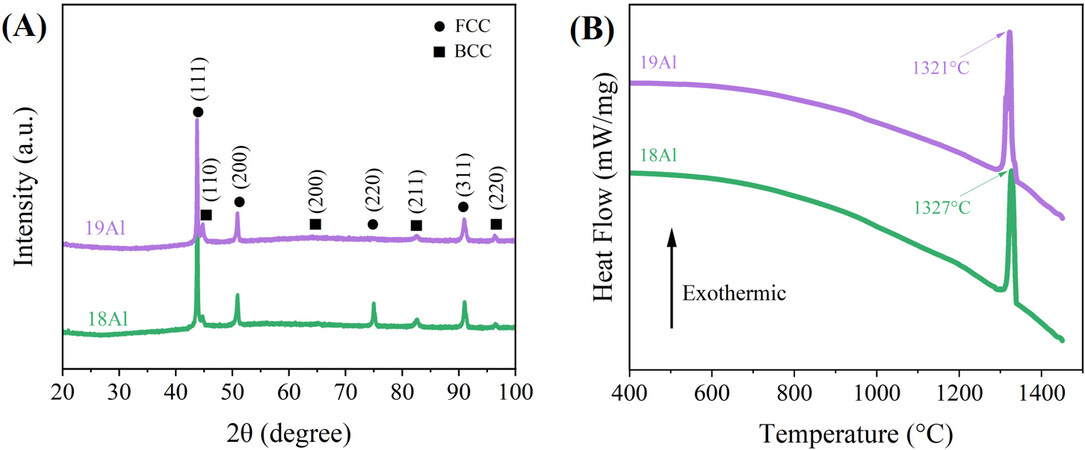
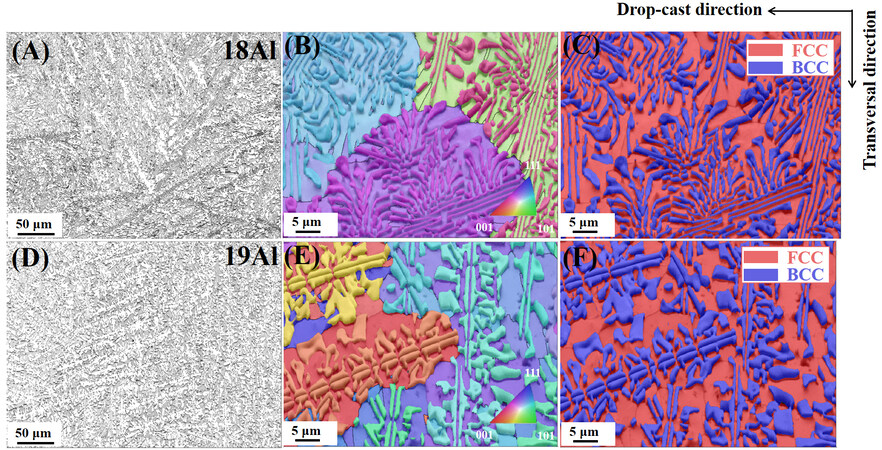
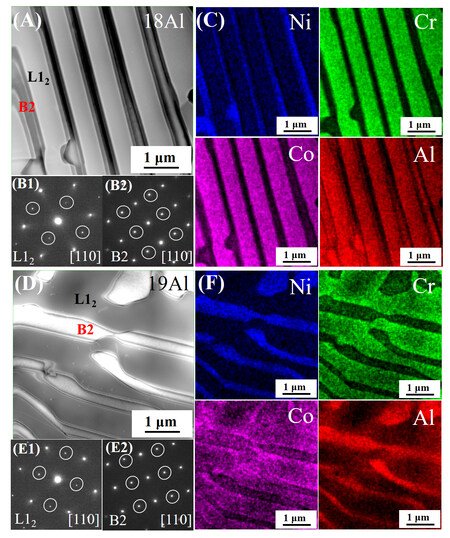
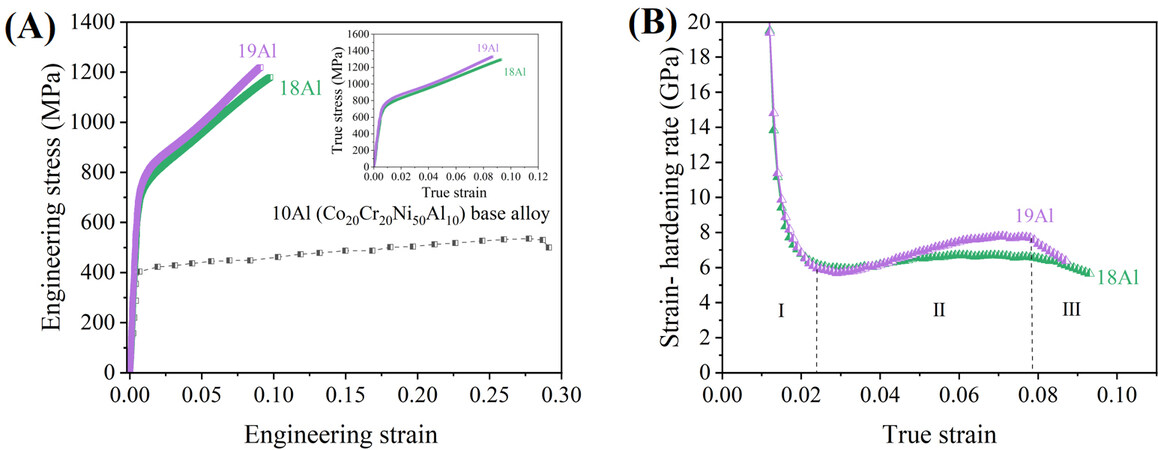
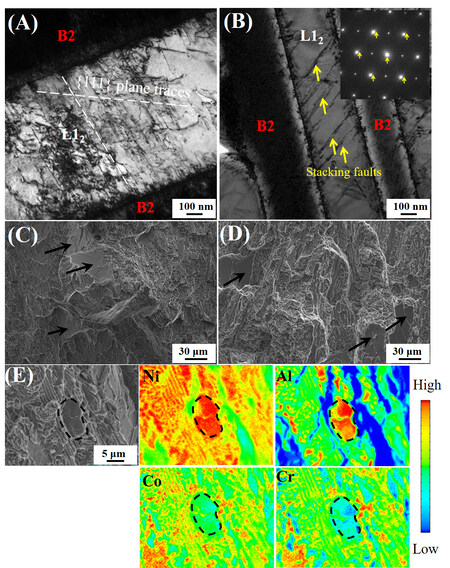









Comments
Comments must be written in English. Spam, offensive content, impersonation, and private information will not be permitted. If any comment is reported and identified as inappropriate content by OAE staff, the comment will be removed without notice. If you have any queries or need any help, please contact us at support@oaepublish.com.